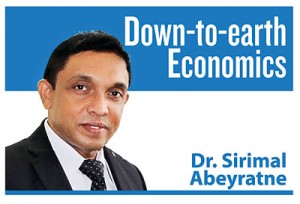Impossible possibilities
View(s):One day a journalist raised an interesting point in a conversation with me over the phone: “It has taken 72 years from Independence for Sri Lanka to reach $4,000 per capita income level. How many more years would we need to become a ‘rich’ country?”
When I began to ponder the point he raised, it became even more interesting. I remembered that 72 years from 1948-2019 means almost three generations! The time has been long enough for a person who was born in 1948 to see his children’s children – grandchildren, and their children too – great grandchildren. This means that he has seen the complete span of three generations; his own generation, his children’s generation, and his grandchildren’s generation.
The duration of a “generation” literally means the number of years that an average person requires from birth up to the time of beginning to have children.
Becoming wealthy
What do we mean by becoming rich for a nation? It is the wealth of a nation. The simplest measure of a nation’s wealth is the per capita income. To become a “rich” nation or precisely a “high-income” nation, the country should have reached the minimum per capita income level of $12,000, according to the standard classification by the World Bank.
Sri Lanka has reached $4,000 per capita income level so that it is now an “upper middle-income” country. The question was that how many more years would we need to see Sri Lanka becoming a “high-income” country.
Can Sri Lanka become a wealthy nation within less than a generation? Let’s look at the realities.
“Mile under four minutes”
“No athlete in the world has run the mile under four minutes. It had been considered an impossibility.”
Dr. Ranjit de Silva, a Leadership Training Teacher, shared a story with me from the new book that he has been writing on. Running a mile in four minutes means maintaining a speed of 15 miles per hour or 24 kilometres per hour, which is impossible!
There is scientific reasoning to prove why it is an impossibility. “Human bone structure is not made to run that fast. The lung power of the human being is inadequate to hold that much pressure. The faster the speed, the greater will be the wind resistance.”
In the early 1950s, however, a young athlete – a British medical student named Roger Bannister, thought he would attempt it. He began training in the evening after his studies, preparing himself to create a first-ever world record. For a thousand years since the time of Greeks who invented Olympic Games, no one has even attempted it.
At that time, perhaps, many would have looked at his motive and preparation sarcastically, and talked about it teasingly: “Don’t even think of trying it – impossible!” For their confirmation, Roger had already failed even to win at Olympic Games in 1952 where he came in fourth place only.

Start of a local race.
But Roger wouldn’t dare to stop for winning the arguments with the grandstand. He had a goal to reach, and focussed on that.
Change in the status quo
A miraculous first-ever world record of running under “sub-four-minute mile” was finally set by Roger Bannister on May 6, 1954 at Iffley Road Track of the Oxford University. He completed the run in 3:59 minutes. Roger was honoured with the “blue plague” – a permanent sign installed at Iffley Road Track to commemorate his unparalleled achievement in the world history.
What was even more exciting to me was that what happened after setting up this first-ever world record. Since then, running under “sub-four-minute mile” did not remain an extraordinary achievement. With Roger’s unparalleled achievement in human history, impossibility became a possibility!
Two months later in the same year, two athletes – Roger Bannister himself and Australia’s John Landy, ran the mile under four minutes again, for the second time. One year after the Bannister’s world record, 37 runners had achieved the same record by running the mile under four minutes.
Two years later 300 runners broke the four-minute mile.
Secret of the possibility
As time passed, many athletes found to have set the records by running faster than Roger Banninster, while some of them did run it even more frequently – sometimes as frequent as 100 times. By today, thousands of athletes from all around the world have completed the “sub-four-minute mile” achievement.
“What happened?” asked Dr. Ranjit de Silva. “How did an impossibility became a norm?”
He explained: “Much more than anything else, it is a result of changing the human attitudes! When no one has done it before in the human history, the attitude was that “it is an impossibility”. You can even prove it with scientific evidence! So nobody even thought of trying it. But if somebody tried and did it, then suddenly there was a great breakthrough in our attitude. Now we look at it as a possibility that influences our behaviour.”
He concluded: “Attitude is a way of thinking that can shape our outward behaviour.”
Economic impossibility
Now, here is my economic theory: Because our attitudes are shaped by our own experience within the past 72 years, we think that Sri Lanka cannot become rich within a generation.
We have articulated and established the scientific reasons for this impossibility: It is our democracy or our elections or our politicians; it is our bureaucracy or regulatory system or our inefficient public enterprises; it is our government, or our lethargic people, or our fatalism and contentedness. Therefore, it is an impossibility, according to our mindset.
Let me elaborate the facts, which have changed our circumstances and which might help us to change the mindset. Throughout the modern history of economic development, the duration required to be a rich country has shortened extremely.
Shortened time for development
The first country to become rich in modern times and in modern sense is England. It took more than 200 years for England to transform from its agriculture-based feudal economy to a modern wealthy nation, and thereby to become the world’s “great economic power.”
This was a transformation that went through an agricultural revolution, industrial revolution, and international trade expansion. Everything that helped creating wealth in England had to be experimented, invented, and innovated, because it was for the “first time” in the world history. And, after all it was a painful transformation for many generations.
But for other European countries, the US and Japan, it didn’t take that long. For the East Asian countries, it was even shorter: For some East and Southeast Asian countries such South Korea, Singapore and Hong Kong, which became the “fastest” countries to become rich, it took only about 10 years to raise their per capita income levels from $4,000 to $12,000.
Malaysia raised its per capita income from $4,000 to $10,000 in 10 years, in spite of its recent slowing down. China, which surpassed $4,000 per capita income in 2010 has also reached to over $9,000 by 2018.
Short cuts to development
In fact, the circumstances are different today so that there are reasons which have made it possible:
Today nations don’t have to waste time by experimenting the policies, as they have been tested and established by other countries. They don’t have to wait that long for generating savings for investment, because there is no shortage of investment funds in the world. There is no need to “re-invent” the wheel developing new technology, as technology is available to buy as a commodity. There is no need to commence voyages looking for markets, as there is open access to markets all around the world.
It is not an impossibility to become a wealthy nation within less than a generation.
(The writer is a Professor of Economics at the University of Colombo and can be reached at sirimal@econ.cmb.ac.lk).


